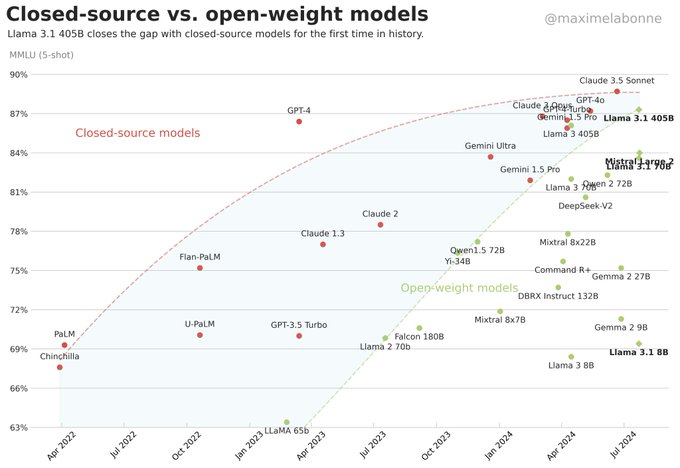Module 0.0 - Introduction¶
Welcome¶
- CS 5781 - Machine Learning Engineering
Contents¶
- Class Context
- Staff Introduction
- Class Goals
- Class Syllabus
Class Context¶
- Development of deep learning models
- Deep learning models in industrial context
- Programming large systems
Context¶
- ChatGPT
- Image Generation
- AI for Science
Context: Space Race¶
Context: Economic Value¶
Context: Social Media¶

Question¶
- How do I "read" one of these models?
- What technology is powering these tools?
- How can I build models for my own problem?
Staff Introduction¶
Professor¶
- Sasha Rush
Academic Work¶
- Website: http://rush-nlp.com/
- Area of Study: Natural Language Processing (NLP)
- Area of Study: Language Models
Academic Work: Projects¶
- Automatic text summarization
- Accurate math OCR
- Machine learning on cell phones
My Path¶
- Coder -> Student -> Industry -> Professor
Intro: Open-Source¶
- Open-source development projects for NLP OpenNMT
- Contributor to PyTorch
- Part-time at Hugging Face
TAs¶
- TAs
Class Introduction¶
Class Focus¶
- Machine Learning Engineering
- Focus: software engineering behind machine learning
Applied Machine Learning¶
- Coverage of different models and learning setups
- Focus on algorithms and mathematical underpinnings
- Broad coverage of the field and its future
Machine Learning Engineering¶
- Focus on implementation details and design
- Deep dive into implementation
- (For those who care about the weeds)
Machine Learning¶
- Rich and interesting field
- Building models is a core skill
- Probabilistic reasoning for decision making
Skill Set of a ML Engineer¶
- Math
- Experimentation
- Systems
Machine Learning Systems¶
Machine Learning Engineering¶
- ML practitioners build large-scale mathematical systems.
- Tooling has been key to speed up ML development.
- Most work done in Deep Learning frameworks.
Deep Learning Frameworks¶
- Implement mathematical functions as efficient code
- Provide organization and structure to ML projects
- Allow for easy training and deployment
- Think: "Programming language for machine learning"
Deep Learning Frameworks¶
Example of code in PyTorch.
In [2]:
class Network(torch.nn.Module):
def __init__(self, hidden):
super().__init__()
self.layer1 = torch.nn.Linear(2, hidden)
self.layer2 = torch.nn.Linear(hidden, hidden)
self.layer3 = torch.nn.Linear(hidden, 1)
def forward(self, x):
h = self.layer1.forward(x).relu()
h = self.layer2.forward(h).relu()
return self.layer3.forward(h).sigmoid()
Deep Learning Frameworks¶
- Used for all the major projects shown.
- Provide easy user programming interface
- Connect to fast hardware under the hood
ML Day-to-Day¶
- Data scientist or ML practitioners and use these systems
- However, an ML Engineer should really know what is going on...
CS 5781¶
Let's build PyTorch.
Course Outline¶
My Learning Philophy¶
- Engineering is learned through implementing
- You don't understand it until the tests pass
- Build your own demos
Learning Objectives¶
- Reason about the requirements for large system systems
- Be comfortable designing and testing mathematical code
- Gain confidence reading large open-source codebases
Learning Non-Objectives¶
- Rigorous understanding of mathematical foundations
- Development of new or creative models
- Details of state-of-the-art ML systems
Course Style¶
- Highly applied, focus on building
- Project directed, questions from students
- Interactive and grounded in the project
PyTorch¶
- Big codebase on CPU and GPU
- Large team of professional developers
- Used in thousands of academic papers
- Deployed by Facebook, Uber, Tesla, Microsoft, OpenAI ...
Challenge¶
How are you going to build PyTorch?
Course Project¶
- 5 modules walking you through the process
- Each covers a different topic in MLE
- Final module yields a full image recognition system.
Course Work¶
class ReLU:
@staticmethod
def forward(ctx, a):
# TODO: Implement for Task 1.2.
raise NotImplementedError('Need to implement for Task 1.2')
@staticmethod
def backward(ctx, d_output):
# TODO: Implement for Task 1.4.
raise NotImplementedError('Need to implement for Task 1.4')
Grading¶
- Assignments - Completion and Correctness
- Midterm
- In-Class Quizzes
- Assignments are done individually
Tools¶
- Github Classroom
- Ed Discussions
- Slido
Caveats¶
Course Prerequisites¶
- Programming experience
- Mathematical notation / calculus experience
- Willingness to debug
Next Lecture¶
- Getting dev setup
- Getting started for Module-0
- Come ready to program.

